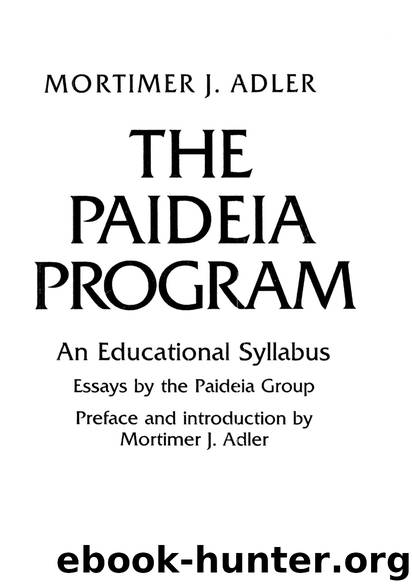The Paideia Program by Mortimer J. Adler

Author:Mortimer J. Adler
Language: eng
Format: epub
Publisher: Touchstone
Published: 1984-01-02T16:00:00+00:00
HOW TO PROCEED: SOME FURTHER DETAILS
Any knowledge of history, however elementary, must be linked from the start with an awareness of where the persons talked of lived, where the events took place. That awareness means: geography. It is best to start talking of geography by referring to places known, at least by name, in the neighborhood—the river, the hill, the mountain ridge seen in the distance, the flats on the other side of the stream. Then perhaps the outline map that is given out does not give false impression of wide open spaces, all white and convenient for settlements and battles to occur in. Ideally, the bare outline to be colored and filled in with names should always be coupled with a physical map showing mountains, forests, and other features. In class, attention should be paid to soil, climate, rainfall, and the other drawbacks or advantages that the earth affords to making a livelihood and developing a civilization: “Why are large cities so often on large rivers? Why did it take so long to settle our continent all the way to California?”
Together with the sense of place, the learner of history must develop a sense of time. This is not easy to do—or to teach. How does one get to feel a difference between 100 years ago, 500 and 1500? Well, 100 years ago may be “when grandfather’s father was alive,” or “when the city hall was built—you can see the date on the cornerstone.” So far, so good. But to stretch that feeling by merely saying or thinking some multiple of 100 such as five or fifteen is not likely to yield results. There must be objects to associate with a time considerably remote. For example, a portrait of Queen Elizabeth I, the Holbein painting of Henry VIII, a drawing of a ship of the Tudor navy; George and Martha Washington in their costumes; the facade of Mount Vernon; the streets of Philadelphia. Conditions, states of mind, can help when made vivid: when Benjamin Franklin drew down the lightning, what exactly was known about electricity? And why should Sir Walter Raleigh lay down his cloak (what’s a cloak?) for the queen to cross a mud patch? How were cities built, kept clean, and policed?
The specific offering of courses must be left to the best judgment of the teacher or department, in keeping with the part of the country or the school population to be served. As an indication of a desirable sequence, the following subjects may be listed as furnishing a conspectus of the historical bases of Western civilization: American History (seventh grade); History of England (eighth); Europe Since 1500 (ninth); Ancient Greece and Rome (tenth); The Middle Ages (eleventh); American History Since 1865 (twelfth).
As to the kinds of teaching recommended for the Paideia curriculum: coaching, lecturing, and discussing are all required, but they require a word or two concerning their application to the study of history. Coaching means giving out reading assignments, with suitable warnings about special difficulties, main points to look for, and the like.
Download
This site does not store any files on its server. We only index and link to content provided by other sites. Please contact the content providers to delete copyright contents if any and email us, we'll remove relevant links or contents immediately.
| Administration | Assessment |
| Educational Psychology | Experimental Methods |
| History | Language Experience Approach |
| Philosophy & Social Aspects | Reform & Policy |
| Research |
The Art of Coaching Workbook by Elena Aguilar(48067)
Trainspotting by Irvine Welsh(20057)
Twilight of the Idols With the Antichrist and Ecce Homo by Friedrich Nietzsche(17707)
Fangirl by Rainbow Rowell(7835)
Periodization Training for Sports by Tudor Bompa(7330)
Change Your Questions, Change Your Life by Marilee Adams(6643)
This Is How You Lose Her by Junot Diaz(5776)
Grit by Angela Duckworth(4738)
Red Sparrow by Jason Matthews(4669)
Asking the Right Questions: A Guide to Critical Thinking by M. Neil Browne & Stuart M. Keeley(4577)
Paper Towns by Green John(4170)
Room 212 by Kate Stewart(4108)
Ken Follett - World without end by Ken Follett(3975)
The Sports Rules Book by Human Kinetics(3590)
Housekeeping by Marilynne Robinson(3403)
The Motorcycle Diaries by Ernesto Che Guevara(3337)
Introduction to Kinesiology by Shirl J. Hoffman(3303)
Exercise Technique Manual for Resistance Training by National Strength & Conditioning Association(3292)
Double Down (Diary of a Wimpy Kid Book 11) by Jeff Kinney(3276)
